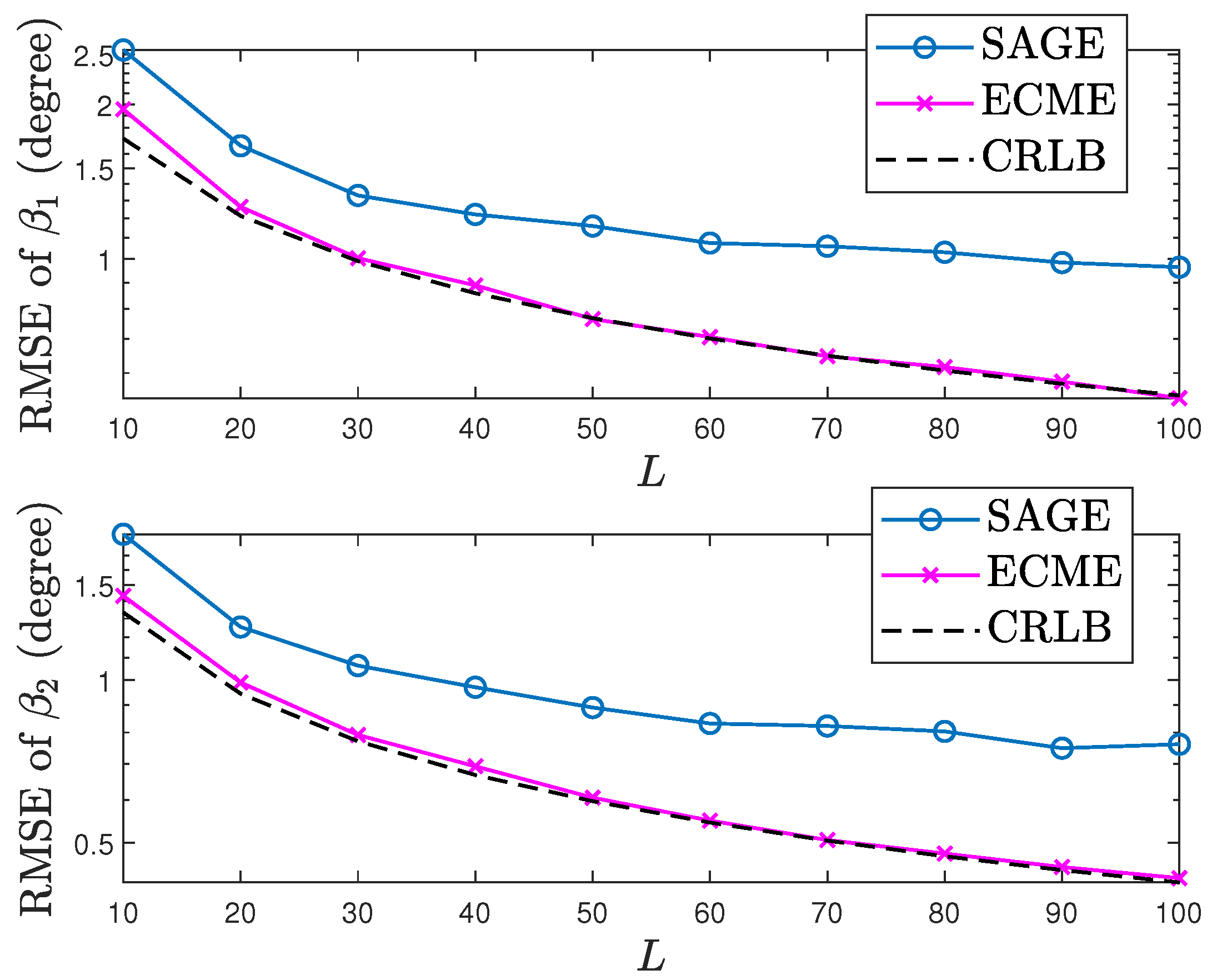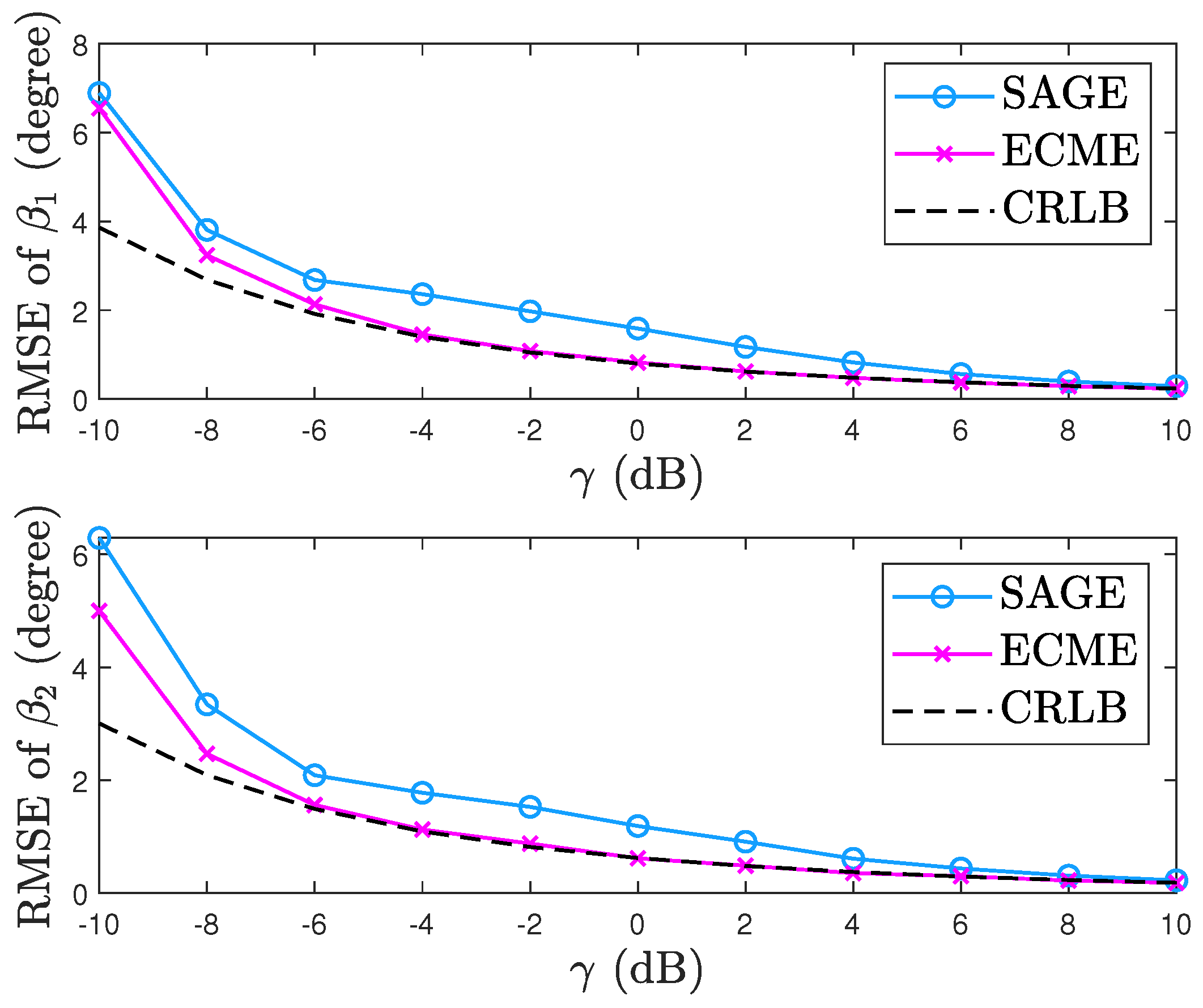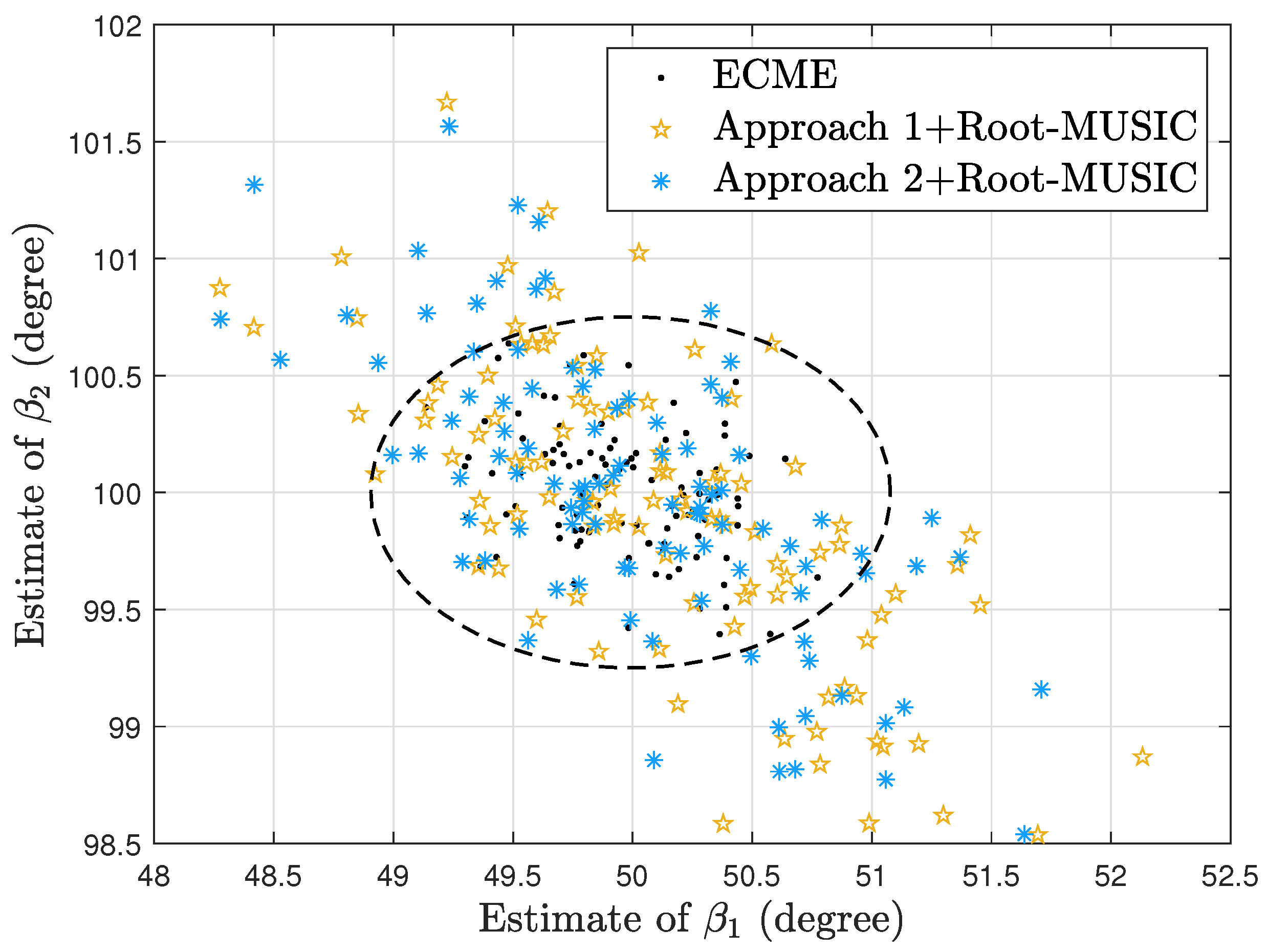Stochastic Maximum Likelihood Direction Finding in the Presence of Nonuniform Noise Fields
Abstract
1. Introduction
2. Problem Statement
3. ECME Algorithm
3.1. Procedure
3.1.1. Expectation Step
3.1.2. Maximization Step
3.1.3. Conditional Maximization Step
| Algorithm 1 Steepest Descent-Based DOA Estimation |
|
3.2. Stability and Complexity
3.3. Limit Point
4. Simulation Results
5. Conclusions
Author Contributions
Funding
Institutional Review Board Statement
Informed Consent Statement
Data Availability Statement
Conflicts of Interest
References
- Stoica, P.; Nehorai, A. MUSIC, maximum likelihood, and Cramer-Rao bound. IEEE Trans. Acoust. Speech Signal Process. 1989, 37, 720–741. [Google Scholar] [CrossRef]
- Stoica, P.; Nehorai, A. Performance study of conditional and unconditional direction-of-arrival estimation. IEEE Trans. Acoust. Speech Signal Process. 1990, 38, 1783–1795. [Google Scholar] [CrossRef]
- Stoica, P.; Larsson, E.G.; Gershman, A.B. The stochastic CRB for array processing: A textbook derivation. IEEE Signal Process. Lett. 2001, 8, 148–150. [Google Scholar] [CrossRef]
- Pesavento, M.; Gershman, A.B. Maximum-likelihood direction-of-arrival estimation in the presence of unknown nonuniform noise. IEEE Trans. Signal Process. 2001, 37, 1310–1324. [Google Scholar] [CrossRef]
- Gershman, A.B.; Pesavento, M.; Stoica, P.; Larsson, E.G. The stochastic CRB for array processing in unknown noise fields. In Proceedings of the 2001 IEEE International Conference on Acoustics, Speech, and Signal Processing, Proceedings (Cat. No. 01CH37221), Salt Lake City, UT, USA, 22–27 May 2001. [Google Scholar]
- Delmas, J.; Abeida, H. Stochastic Cramer-Rao bound for noncircular signals with application to DOA estimation. IEEE Trans. Signal Process. 2004, 52, 3192–3199. [Google Scholar] [CrossRef]
- Abeida, H.; Delmas, J. Gaussian Cramer-Rao bound for direction estimation of noncircular signals in unknown noise fields. IEEE Trans. Signal Process. 2005, 53, 4610–4618. [Google Scholar] [CrossRef]
- Ziskind, I.; Wax, M. Maximum likelihood localization of multiple sources by alternating projection. IEEE Trans. Acoust. Speech Signal Process. 1988, 36, 1553–1560. [Google Scholar] [CrossRef]
- Miller, M.I.; Fuhrmann, D.R. Maximum-likelihood narrow-band direction finding and the EM algorithm. IEEE Trans. Acoust. Speech Signal Process. 1990, 38, 1560–1577. [Google Scholar] [CrossRef]
- Chung, P.; Bohme, J.F. Comparative convergence analysis of EM and SAGE algorithms in DOA estimation. IEEE Trans. Signal Process. 2001, 49, 2940–2949. [Google Scholar] [CrossRef]
- Gong, M.; Lyu, B. Alternating maximization and the EM algorithm in maximum-likelihood direction finding. IEEE Trans. Veh. Technol. 2021, 70, 9634–9645. [Google Scholar] [CrossRef]
- EM and SAGE Algorithms for DOA Estimation in the Presence of Unknown Uniform Noise. Available online: https://arxiv.org/abs/2208.07510 (accessed on 16 August 2022).
- Zoubir, A.M.; Aouada, S. High resolution estimation of directions of arrival in nonuniform noise. In Proceedings of the 2004 IEEE International Conference on Acoustics, Speech, and Signal Processing, Montreal, QC, Canada, 17–21 May 2004. [Google Scholar]
- Madurasinghe, D. A new DOA estimator in nonuniform noise. IEEE Signal Process. Lett. 2005, 12, 337–339. [Google Scholar] [CrossRef]
- Liao, B.; Chan, S.; Huang, L.; Guo, C. Iterative methods for subspace and DOA estimation in nonuniform noise. IEEE Trans. Signal Process. 2016, 64, 3008–3020. [Google Scholar] [CrossRef]
- Liao, B.; Huang, L.; Guo, C.; So, H.C. New approaches to direction-of-arrival estimation with sensor arrays in unknown nonuniform noise. IEEE Sens. J. 2016, 16, 8982–8989. [Google Scholar] [CrossRef]
- Esfandiari, M.; Vorobyov, S.A.; Alibani, S.; Karimi, M. Non-iterative subspace-based DOA estimation in the presence of nonuniform noise. IEEE Signal Process. Lett. 2019, 26, 848–852. [Google Scholar] [CrossRef]
- Esfandiari, M.; Vorobyov, S.A. A novel angular estimation method in the presence of nonuniform noise. In Proceedings of the ICASSP 2022—2022 IEEE International Conference on Acoustics, Speech and Signal Processing (ICASSP), Singapore, 23–27 May 2022. [Google Scholar]
- Chen, C.E.; Lorenzelli, F.; Hudson, R.E.; Yao, K. Stochastic maximum-likelihood DOA estimation in the presence of unknown nonuniform noise. IEEE Trans. Signal Process. 2008, 56, 3038–3044. [Google Scholar] [CrossRef]
- EM-Type Algorithms for DOA Estimation in Unknown Nonuniform Noise. Available online: https://arxiv.org/abs/2211.02458 (accessed on 4 November 2022).
- Liu, C.; Rubin, D.B. The ECME algorithm: A simple extension of EM and ECM with faster monotone convergence. Biometrika 1994, 81, 633–648. [Google Scholar] [CrossRef]
- Jaffer, A.G. Maximum likelihood direction finding of stochastic sources: A separable solution. In Proceedings of the ICASSP-88, International Conference on Acoustics, Speech, and Signal Processing, New York, NY, USA, 11–14 April 1988. [Google Scholar]
- Stoica, P.; Nehorai, A. On the concentrated stochastic likelihood function in array signal processing. Circuits Syst. Signal Process. 1995, 14, 669–674. [Google Scholar] [CrossRef]
- Bresler, Y. Maximum likelihood estimation of linearly stmctured covariance with application to antenna array processing. In Proceedings of the 4th ASSP Workshop Spectrum Estimation Modeling, Minneapolis, MN, USA, 3–5 August 1988. [Google Scholar]
- Stoica, P.; Ottersten, B.; Viberg, M.; Moses, R.L. Maximum likelihood array processing for stochastic coherent sources. IEEE Trans. Signal Process. 1996, 44, 96–105. [Google Scholar] [CrossRef]
- Dempster, A.P.; Laird, N.M.; Rubin, D.B. Maximum likelihood from incomplete data via the EM algorithm. J. Roy. Statist. Soc. Ser. B (Methodol.) 1977, 39, 1–38. [Google Scholar]
- Rhodes, I.B. A tutorial introduction to estimation and filtering. IEEE Trans. Autom. Control 1971, 16, 688–706. [Google Scholar] [CrossRef]
- Jeff Wu, C.F. On the convergence properties of the EM algorithm. Ann. Statist. 1983, 11, 95–103. [Google Scholar]
- Stoica, P.; Gershman, A.B. Maximum-likelihood DOA estimation by data-supported grid search. IEEE Signal Process. Lett. 1999, 6, 273–275. [Google Scholar] [CrossRef]
- Malioutov, D.; Cetin, M.; Willsky, A.S. A sparse signal reconstruction perspective for source localization with sensor arrays. IEEE Trans. Signal Process. 2005, 53, 3010–3022. [Google Scholar] [CrossRef]



Disclaimer/Publisher’s Note: The statements, opinions and data contained in all publications are solely those of the individual author(s) and contributor(s) and not of MDPI and/or the editor(s). MDPI and/or the editor(s) disclaim responsibility for any injury to people or property resulting from any ideas, methods, instructions or products referred to in the content. |
© 2023 by the authors. Licensee MDPI, Basel, Switzerland. This article is an open access article distributed under the terms and conditions of the Creative Commons Attribution (CC BY) license (https://creativecommons.org/licenses/by/4.0/).
Share and Cite
Gong, M.-Y.; Lyu, B. Stochastic Maximum Likelihood Direction Finding in the Presence of Nonuniform Noise Fields. Electronics 2023, 12, 2191. https://doi.org/10.3390/electronics12102191
Gong M-Y, Lyu B. Stochastic Maximum Likelihood Direction Finding in the Presence of Nonuniform Noise Fields. Electronics. 2023; 12(10):2191. https://doi.org/10.3390/electronics12102191
Chicago/Turabian StyleGong, Ming-Yan, and Bin Lyu. 2023. "Stochastic Maximum Likelihood Direction Finding in the Presence of Nonuniform Noise Fields" Electronics 12, no. 10: 2191. https://doi.org/10.3390/electronics12102191
APA StyleGong, M.-Y., & Lyu, B. (2023). Stochastic Maximum Likelihood Direction Finding in the Presence of Nonuniform Noise Fields. Electronics, 12(10), 2191. https://doi.org/10.3390/electronics12102191








